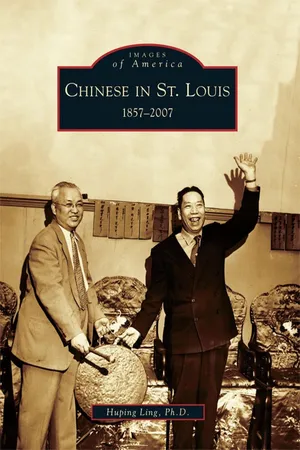
- 128 pages
- English
- ePUB (mobile friendly)
- Available on iOS & Android
About this book
In 1857, Alla Lee, a 24yearold native of Ningbo, China, seeking a better life, came to St. Louis. A decade later, Lee was joined by several hundred of his countrymen from San Francisco and New York who were seeking jobs in mines and factories in and around St. Louis. Most of these Chinese workers lived in boardinghouses located near a street called Hop Alley. In time, Chinese hand laundries, merchandise stores, herb shops, restaurants, and clan association headquarters sprang up in and around that street, forming St. Louis Chinatown. Hop Alley survived with remarkable resilience and energy until 1966 when urban renewal bulldozers leveled the area to make a parking lot for Busch Stadium. A new suburban Chinese American community has been quietly, yet rapidly, emerging since the 1960s in the form of cultural community, where the Chinese churches, Chineselanguage schools, and community organizations serve as the infrastructure of the community.
Frequently asked questions
- Essential is ideal for learners and professionals who enjoy exploring a wide range of subjects. Access the Essential Library with 800,000+ trusted titles and best-sellers across business, personal growth, and the humanities. Includes unlimited reading time and Standard Read Aloud voice.
- Complete: Perfect for advanced learners and researchers needing full, unrestricted access. Unlock 1.4M+ books across hundreds of subjects, including academic and specialized titles. The Complete Plan also includes advanced features like Premium Read Aloud and Research Assistant.
Please note we cannot support devices running on iOS 13 and Android 7 or earlier. Learn more about using the app.
Information
Table of contents
- Title Page
- Copyright Page
- Dedication
- Table of Contents
- ACKNOWLEDGMENTS
- INTRODUCTION
- One - COMING TO AMERICA
- Two - BUILDING HOP ALLEY
- Three - LIVING IN HOP ALLEY
- Four - COMMUNITY IN TRANSITION
- Five - A NEW ECONOMY
- Six - CONSTRUCTING CULTURAL COMMUNITY
- BIBLIOGRAPHY